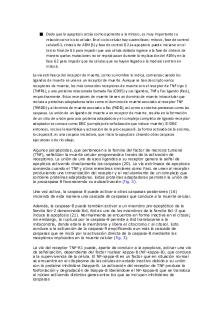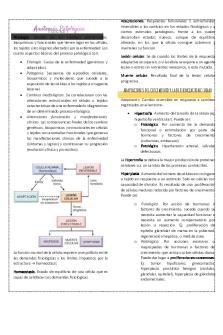1 Apoptosis Vs Necrosis PDF

| Title | 1 Apoptosis Vs Necrosis |
|---|---|
| Course | Exploring Human Disease - Science |
| Institution | University of Melbourne |
| Pages | 3 |
| File Size | 217.2 KB |
| File Type | |
| Total Downloads | 87 |
| Total Views | 144 |
Summary
Apoptosis Necrosis...
Description
NECROSIS
APOPTOSIS
Large number of cells die
Cell shrinks and engulfed by phagocyte Regulated form of cell death which may be both physiological and pathological
⬆eosinophilic staining – denatured proteins and loss of RNA Vacuolation – digested cytoplasmic organelles ER and Mt swelling Discontinuous membranes
CAUSES
Coagulative - Denaturation of proteins - Cells dead - Tissue architecture preserved Liquefactive - Enzymatic digestion of ALL macromolecules - Cells digested - No tissue structure - Inflammatory response Caseous - Tissue architecture obliterated - Fragmented lysed cells with amorphous granular appearance Fat
Ischemia Bacterial and fungal infection; ischemia Mycobacterium tuberculosis Acute pancreatitis Leakage of fibrin and inflammatory cells Lower limb has lost its blood supply
- Focal areas of fat destruction - Enzymes liquify membranes of fat cells - Release fatty acids ➙ mix with Ca ➙ white lesions Fibrinoid - Deposition of immune complexes in blood vessels
Intensely eosinophilic cytoplasm Nuclear chromatin condensed and fragmented Formation of apoptotic bodies NO inflammatory response
Physiological Embryogenesis Involution Cell loss in proliferating cell population Elimination of cells that have reached their used by date Self-reactive T-lymphocytes Pathological -
DNA damage Accumulation of misfolded protein Cell death in infection Pathologic atrophy
Intrinsic Pathway Growth factor withdrawal DNA damage Protein misfolding There is a balance b|w pro- and anti-apoptotic members of the Bcl-2 family Extrinsic Pathway Cytotoxic T-cell recognition of infected cells Elimination of lymphocytes that fight self-cells
CAUSES Radiation, cytotoxic drugs, extreme temp., hypoxia, ROS Mutations, ROS, degeneration in CNS
Viral infection, host eliminating infected cells
Gangrenous - Coagulative/liquidative - Lower limb Cell size
Enlarged – swollen
Reduced
Nucleus
Breakdown of DNA and chromatin Pyknosis: nuclear shrinkage and ⬆ basophilia (condensed) Karyorrhexia: nuclear fragmentation Karyolysis: ⬇ basophilia from DNA breakdown
Plasma membrane
disrupted
intact BUT altered
Cellular contents
enzymatic digestion leakage
intact apoptotic bodies
Inflammati on
Y
N
Karyorrhexia
Necroptosis Hybrid form of cell death - Features of necrosis o Loss of ATP o Cell and organelle swelling o Generation of ROS o Rupture of cell membrane - Features of apoptosis o Genetically programmed signal transduction events - Different o Initiated by ligation of receptor with ligand o Caspase independent...
Similar Free PDFs

1 Apoptosis Vs Necrosis
- 3 Pages

Apoptosis Celular
- 6 Pages

Isquemia, lesion y necrosis
- 14 Pages

Tipos de apoptosis
- 5 Pages

Samali -apoptosis -Bcl-2
- 2 Pages

Apoptosis - Summary Cell Biology
- 4 Pages

Apoptosis y Muerte Somática
- 18 Pages

Exam questions for apoptosis
- 3 Pages

Vía extrínseca de la apoptosis
- 1 Pages

1. Addison\'s vs. Cushings
- 1 Pages

PKWT VS PKWTT 1
- 2 Pages
Popular Institutions
- Tinajero National High School - Annex
- Politeknik Caltex Riau
- Yokohama City University
- SGT University
- University of Al-Qadisiyah
- Divine Word College of Vigan
- Techniek College Rotterdam
- Universidade de Santiago
- Universiti Teknologi MARA Cawangan Johor Kampus Pasir Gudang
- Poltekkes Kemenkes Yogyakarta
- Baguio City National High School
- Colegio san marcos
- preparatoria uno
- Centro de Bachillerato Tecnológico Industrial y de Servicios No. 107
- Dalian Maritime University
- Quang Trung Secondary School
- Colegio Tecnológico en Informática
- Corporación Regional de Educación Superior
- Grupo CEDVA
- Dar Al Uloom University
- Centro de Estudios Preuniversitarios de la Universidad Nacional de Ingeniería
- 上智大学
- Aakash International School, Nuna Majara
- San Felipe Neri Catholic School
- Kang Chiao International School - New Taipei City
- Misamis Occidental National High School
- Institución Educativa Escuela Normal Juan Ladrilleros
- Kolehiyo ng Pantukan
- Batanes State College
- Instituto Continental
- Sekolah Menengah Kejuruan Kesehatan Kaltara (Tarakan)
- Colegio de La Inmaculada Concepcion - Cebu




